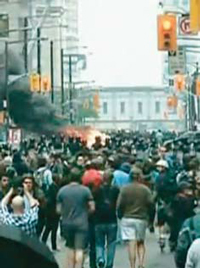 Images of burning police cruisers and kettled protestors dominated the news for weeks after the G20 summit in Toronto last June. The media frenzy has died down, but the legal work is just beginning. More than 1,100 people were detained or arrested during the summit, marking the largest mass arrest in Canadian history. While the majority were released in the days following the protests or had their charges dropped in late August, many continue to face charges.
Images of burning police cruisers and kettled protestors dominated the news for weeks after the G20 summit in Toronto last June. The media frenzy has died down, but the legal work is just beginning. More than 1,100 people were detained or arrested during the summit, marking the largest mass arrest in Canadian history. While the majority were released in the days following the protests or had their charges dropped in late August, many continue to face charges.
But individuals affected by police actions are on the offensive as much as the defensive, questioning the legality of the tactics that security forces employed. Advocacy groups such as the Law Union of Canada are encouraging individuals to file complaints or launch claims against police for alleged wrongdoings.
But should defendants sue police while their charges are outstanding? Bill Thompson of Sack Goldblatt Mitchell LLP, who represents 23-year-old Erik Lankin, one of 18 alleged ringleaders facing conspiracy charges, says, “Typically the advice is to wait until the criminal process has run its course and then to pursue civil remedies.” Otherwise, an accused might forfeit his right to silence. Lankin, who Thompson says doesn’t plan to sue, was incarcerated for two months before being released on $110,000 bail.
Individual lawsuits aren’t the only recourse, though. Two class actions have been launched, one on behalf of individuals who were detained or arrested but not charged, and another that also covers persons facing criminal charges. Both are pending certification and a carriage motion will be brought to address the overlap between the claims.
Lawyers Eric Gillespie and Murray Klippenstein launched the first class action on behalf of representative plaintiff Sherry Good, an office administrator who was one of hundreds of people that riot police encircled and detained for hours in a downpour.
While the Toronto Police Services Board and the Ontario ombudsperson have ordered reviews of policy, calls for a wide-scale public inquiry have fallen flat. A class action may be the best alternative, says Gillespie.
“Members of the legal community and the public across Canada have expressed grave concerns about the events that transpired over the G20 weekend, their impacts on Charter rights and on our basic understanding of how policing and security in Canada should be managed,” he explains. “A class action appears to be the only way that full judicial examination and intervention can occur.”
Also on the case
Speaking up for speech: John Norris, Barrister
Alex Hundert, one of the alleged organizers charged with conspiracy, was released on bail in July, but rearrested in September for speaking on a post-G20 panel at Ryerson University. A month later Hundert was released again, but was prohibited from speaking to media or posting content on the internet — restrictions that are alarming to defenders of free speech. In late October, Hundert was rearrested again on charges of attempting to intimidate a member of the justice system.
Bursting Officer Bubbles: James Zibarras, Brauti Thorning Zibarras Barristers
Constable Adam Josephs of the Toronto Police Service, who earned the moniker “Officer Bubbles” after threatening to arrest a protester for blowing soap bubbles, wants payback. A YouTube video of the incident generated a string of cartoon responses depicting a buffoonish “Officer Bubbles” acting incompetently. Josephs has launched a $1.25 million lawsuit against YouTube and those who created the cartoons or commented on them.
Biting the rubber bullet: Clayton Ruby and Brian Shiller, Ruby & Shiller Barristers
Twenty-year-old Natalie Gray says that she was protesting peacefully when she was shot with rubber bullets, arrested, strip-searched and detained for 30 hours before being released on bail. All charges against Gray were dropped, but she’s now seeking $1 million in damages from the officers involved and the Toronto Police Services Board.

